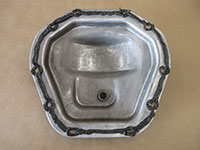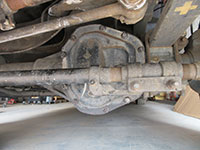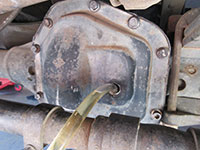Dana 60 Front Differential Oil Selection & Service Intervals
Ford calls for an SAE 80W-90 gear oil in its Ford Super Duties equipped with the Dana 60 front differential. A SAE 90W hypoid gear oil is also referenced in select service material from Ford, although this specification is largely redundant and we recommend the more common 80W-90 spec. A full synthetic oil is not required, but is highly recommended due to its superior lubricating properties and resilience to chemical, thermal, and mechanical breakdown. We highly recommend Amsoil Severe gear 80W-90, a quality full synthetic option.
1999 to 2007 model year vehicles call for the front differential oil to be changed every 100,000 miles under normal service conditions and every 30,000 miles under severe service conditions. 2008 to 2011 model year vehicles call for the front differential oil to be changed every 150,000 miles under normal service conditions and every 50,000 miles under severe service conditions. Vehicles will fall under the severe service category if they are driven off-road and/or 4 wheel drive is engaged frequently. If using a conventional (non-synthetic) gear oil, we recommend adhering to the severe service interval regardless. Differential fluid should be changed as quickly as possible anytime a differential is submerged as water intrusion and contamination is likely.
Dana 60 Gear Oil Recommendations
Diesel Hub recommends the following gear oils for all Dana 60 differentials
Amsoil 80W-90 Severe Gear synthetic gear oil
Superior differential protection, OEM recommended gear oil viscosity
Amsoil synthetic "Severe Gear" gear oil benefits include:
• Extreme pressure, anti-wear formula provides maximum protection against wear, pitting, and scoring due to metal-on-metal contact
• Superior performance and stability in extreme hot and cold operating conditions
• Long lasting proprietary formula resists degradation from mechanical and thermal breakdown
Dana 60 Front Differential Service Procedures
Click any thumbnail to view fullsize, detailed image
• Park the vehicle on level ground and set the parking brake. If vehicle is parked at an angle, the differential housing may not drain properly and/or may not be refilled with the correct amount of oil.
• Locate the fill plug and loosen it with a 3/8" square drive; leave it hand tight so it can easily be removed in the future.
• Loosen (2) of the top differential cover/pan bolts with a 9/16" socket, then back them out about half way. Completely remove the remaining (8) bolts. The top bolts left in will hold the pan in place until it is ready to be removed.
Note - on some applications, a socket head screw is used in place of a hex bolt near the leaf spring hanger; use a 5/16" Allen/hex bit.
• Carefully pry the differential cover from the differential housing using a razor blade, putty knife, and/or small screw driver. Some pans are more stubborn than others, but be patient and careful not to mar the machined surface of the differential housing, which could compromise the cover seal in subsequent steps.
• Allow the differential oil to drain completely, then remove the remaining differential cover bolts followed by the cover itself.
• Thoroughly clean the differential cover with a mild solvent (i.e. brake cleaner). All remnants of oil, silicon sealant, and/or gasket material should be removed completely.
• Cover the differential and gear assembly with a large garbage bag (or similar) to protect it. Thoroughly clean the cover mounting surface of the differential housing; all remnants of oil, silicon sealant, and/or gasket material should be removed completely.
• Remove the garbage bag from inside the differential housing and wipe the mounting surface clean with a mild solvent to remove any oil residue.
• Apply a thin 1/8 to 1/4 inch bead of RTV silicon/gasket maker around the circumference of the differential cover and all bolt holes.
Note - if preferred, a gasket can be used in lieu of or in addition to a silicon sealant. Most modern differentials are factory sealed with silicon only. We highly recommend Permatex Ultra Black RTV silicon for its high oil resistance.
• Carefully line up and install the differential cover, then install the mounting bolts hand tight.
• Snug bolts in a criss-cross/alternating sequence, then torque to ~ 30 ft-lbs.
• Allow the silicon sealant to cure per the product's instructions (typically ~ 24 hours).
• Remove the fill plug and add oil until it begins to run out of the bottom of the fill plug hole, then reinstall and snug the fill plug. A hand pump is recommended for adding differential fluid since access is limited.
• Recommend driving vehicle at low speed with 4 wheel drive engaged, then checking for leaks.











